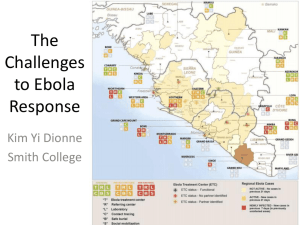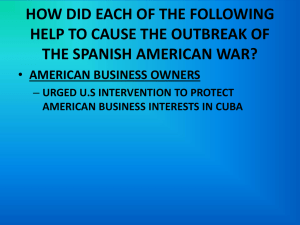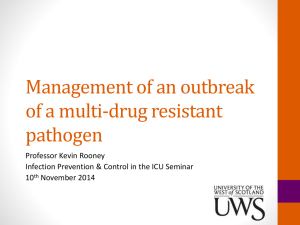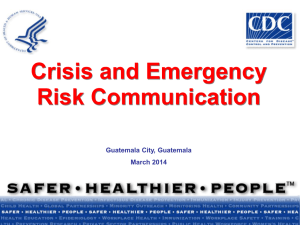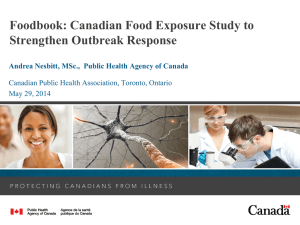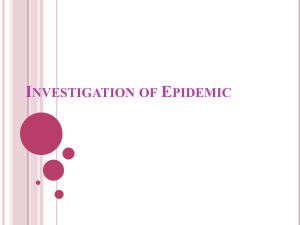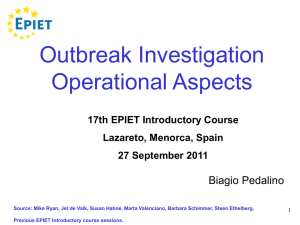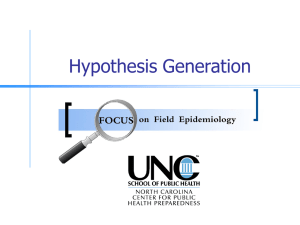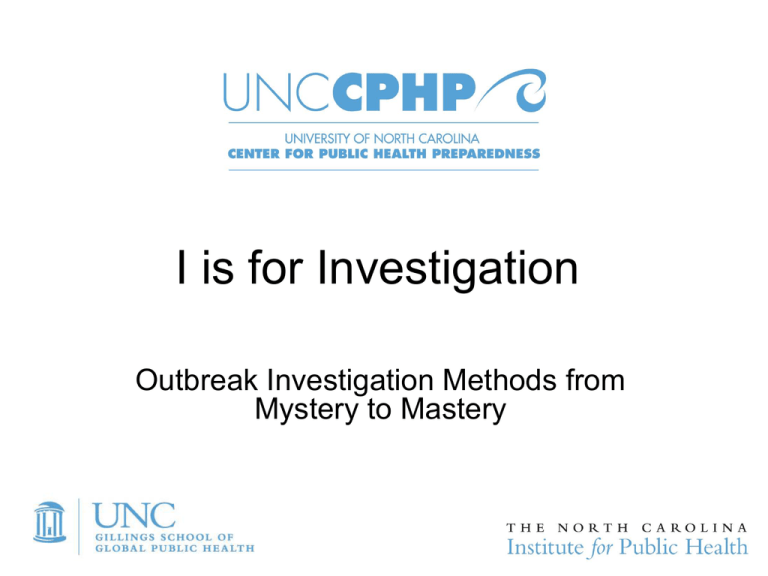
I is for Investigation
Outbreak Investigation Methods from
Mystery to Mastery
Session VI
Writing an Outbreak
Report
Session Overview
• Outbreak report function and structure
• Case studies
– Mycobacterium skin infection outbreak in New
York in 2012
– Multistate outbreak of listeriosis in 2011
Learning Objectives
• Explain the role of outbreak investigation
reports
• Describe different types of outbreak
reports
• List elements to include in outbreak
investigation reports
Basic Steps of an
Outbreak Investigation
•
•
•
•
•
•
•
•
Verify the diagnosis and confirm the outbreak
Define a case and conduct case finding
Tabulate and orient data: time, place, person
Take immediate control measures
Formulate and test hypothesis
Plan and execute studies
Implement and evaluate control measures
Communicate findings
Outbreak Report Function and
Structure
Why Communicate the
Findings?
• Serves as a document for action
• Gives insight about pathogen or
transmission mechanism
• Documents the magnitude of health
problems and justifies activities
• Serves as a performance measure for
Public Health Preparedness capabilities
• Is a basis for research or evaluation
Communicating Findings
• Prevent future outbreaks
• Assist in investigation
and control of similar
incidents
• Provide a document for
potential legal issues
Why are Outbreak Reports
Crucial to Public Health?
Example: Foodborne outbreak
Invasive listeriosis in Louisiana, Jan-June 2010
•
•
•
First outbreak to implicate hog head cheese
Voluntary recall by producer
Publication served to
–
–
–
Inform public health practitioners about new
transmission vehicle
Emphasize food safety requirements
Alert high risk populations
Why are Outbreak Reports
Crucial to Public Health?
Example: Respiratory disease outbreak
• 1996 Legionnaire’s Disease (LD) outbreak
associated with a whirlpool spa display
– Exposure from walking by or being near spa
• 1999 LD outbreak at a flower show in the
Netherlands
– Source: whirlpool spas on display
– Lawsuit raised against Dutch government
– Failure to act on available knowledge (1996
MMWR)
Some Reports are a Part of History
John Snow
Image Source: www.circleofblue.org
Some Reports are a Part of History
Morbidity and Mortality Weekly Report (CDC), June 5, 1981
When is the Report Written?
• When the investigation is ‘complete’
• When the investigation is ‘ongoing’
– Preliminary results impact public health /
medical practice
– High profile or high interest
– Long investigation
– Often include disclaimer
Who Writes the Report?
• The outbreak / field epidemiology team
– Visiting EIS officer
– Epidemiologist, environmental health,
laboratorians, clinicians
– Participating state or federal agencies
All participating
agencies must
approve the report.
Types of Reports
• Complaint form
• Internal report
– Record that outbreak occurred and investigation was
conducted
• State publications
– Newsletter, bulletin, website, press release or alert
• National bulletin
– MMWR http://www.cdc.gov/mmwr/
• Peer-Reviewed Journals
– Epidemiology and Infection, Emerging Infectious
Diseases, Journal of Hospital Infection
Peer-Reviewed Articles
http://www.ncbi.nlm.nih.gov/pubmed
Research Outbreak Updates
• MMWR: http://www.cdc.gov/mmwr/
• FoodNet: www.cdc.gov/foodnet/
• Bulletin of the World Health Organization
www.who.int/bulletin/
• ProMED-mail listserv
www.promedmail.org
Basic Report Structure
•
•
•
•
•
•
•
Context / background
Initiation of investigation
Investigation methods
Findings / results
Discussions and/or conclusions
Recommendations
Acknowledgements
+Supporting Documentation
Length of Report
• Bulletin article
– 1-2 pages (500-1000 words)
• Internal report
– 2-3 pages
• Peer-reviewed manuscript
– 4-8 pages
Context and Background
• Description of the problem
– Suspected or known etiology
– Signs, symptoms, diagnoses
– Time of occurrence
• Population affected
• Location / and geographical areas
involved
Initiation of Investigation
• How notification was
received
• Date and time
notification was received
by the agency
• Date and time
investigation was
initiated
Methods
• Initial activity / verification
– Laboratory results, case finding efforts
• Data collection and analysis methods
–
–
–
–
Case definition and case identification
Epidemiologic study design
Environmental or clinical sample collection
Review of reports
• Exposure assessment and classification
• Tools used
– Questionnaires, epidemic curves, attack rates
Epidemiological Results
• Questionnaire / interview response rate
• Cases
–
–
–
–
Number
Descriptive and clinical data
Geographic distribution of cases
Epidemic curve
• Attack rates by age, sex, exposure
• Risk factor analysis, including ORs / RRs
if applicable
Laboratory, Clinical, and
Environmental Results
• Laboratory results
– Findings from clinical or environmental testing
– Genotyping, DNA fingerprinting, culture
results
• Environmental
– Results of any risk assessments
– Results of any traceback investigation
Discussion and/or Conclusions
• Discuss main hypotheses and public
health impact of findings
• Note problems or limitations that could
impact results
• Present conclusions about the cause of
the outbreak
Recommendations
• Uses
– To control or mitigate this outbreak
– To prevent future outbreaks
– To improve management of future outbreaks
• Basis
– Investigation obstacles and shortcomings
– Outbreak causes
Acknowledgements
• Key investigators
• Report authors
• Both names and titles
Supporting Documentation
Also include the following:
Graphs and tables
Inspection reports
Blank samples of surveys
Letters to management
Menus
Copies of posted notices
Testing results
Press releases
Maps
Case Studies
Case Study 1
Outbreak of Mycobacterium
chelonae Infection Associated with Tattoo
Ink
Kennedy, Bedard, Younge, et al. N Engl J Med 2012;
367:1020-1024. September 13, 2012.
Tattoo Ink Outbreak
Context and Background
• Pathogen
– Not a common cause of skin infections
• Setting
– Previous case reports and outbreaks
– General description of current outbreak
Initiation of Investigation
• Dermatologist reported case to health
department
Stain showing AcidFast Bacilli
Kennedy et al. NEJM
2012; 367:1020-1024
Tattoo Ink Outbreak
Epidemiologic Methods
• Interviews and site visit
– Index patient
– Tattoo artist and studio
• Additional case finding
– Laboratories and tattoo parlors
– Assessment and treatment
Tattoo Ink Outbreak
Laboratory Methods
• Laboratories
used
• Samples tested
• Tests performed
Typical Rash Associated with Mycobacterium
chelonae Infection
Kennedy et al. NEJM 2012; 367:1020-1024
Tattoo Ink Outbreak
Epidemiologic Results
• Ink purchased in April, additional supply ordered
later
• 19 cases (15 confirmed, 4 probable, 1 suspected)
– 13 men, 6 women
– Age range 18 – 48 years
• Attack rate among parlor patrons
– 0% May-August 2011
– 65% in November 2011
Tattoo Ink Outbreak
Laboratory Results
• Biopsy from 17 of 19 case patients
– Microscopic evidence in all samples
– M. chelonae isolated from 14 of 17 samples
• CDC confirmed same M. chelonae genetic
pattern in 11 clinical samples and 1
unopened bottle of ink
• No M. chelonae found in environmental
samples from tattoo parlor
Tattoo Ink Outbreak
Discussion and Conclusions
• Conclusion:
Ink, not tattoo parlor, was source of infection
• Discussion
– Brief review of mycobacterial contamination
during tattoo procedures
– Limitations
– Implication of possible under-reporting of
cutaneous mycobacterium infections
Tattoo Ink Outbreak
Recommendations
• Educate tattoo artists and patrons
– State laws related to tattooing
– Best practices
– Risks
– Signs of a reaction and steps to take
• CDC issued nationwide alert
– Manufacturer issued voluntary recall
• Enhanced oversight needed for tattoo
parlors and ink manufacturing
Case Study 2
Multistate Outbreak of Listeriosis
Associated with Jensen Farms Cantaloupe
--- United States, August--September 2011
MMWR October 7, 2011 / 60(39);1357-1358
http://www.cdc.gov/mmwr/preview/mmwrhtml/mm6039a5.htm?s_cid=mm6039a5_w
Multistate Listeriosis Outbreak
Context and Background
•
•
•
•
5 sentences
Pathogen
Transmission
Clinical signs and
symptoms
• Public health concern
• Treatment
Listeria electron micrograph.
Photo: CDC/ Dr. Balasubr Swaminathan;
Peggy Hayes, 2002
Multi-state Listeriosis Outbreak
Initiation of Investigation
• 3 sentences
• September 2, 2011
– Colorado Dept. of Public Health and Environment
reported 7 cases of listeriosis to CDC since Aug 28
– Normal = 2 cases in August
• Patient interviews using Listeria Initiative
questionnaires
– All 7 reported eating cantaloupe
– 3 reported eating Rocky Ford cantaloupe
Multi-state Listeriosis Outbreak
Investigation Methods
• 2 sentences
• Case definition
• Criteria for identifying outbreak strain of L.
monocytogenes
– 3 possible PFGE patterns
• Criteria for comparison group
Multistate Listeriosis Outbreak
Epidemiologic Results
• Outcome information
– 19 initial cases identified
• OR for cantaloupe 14.9 (95% CI 2.4, ∞)
• Cantaloupe traceback
– Jenson Farms, Colorado
Multistate Listeriosis Outbreak
Results
• PulseNet identified an additional, multi-state
cluster with a 4th PFGE pattern associated
with cantaloupe consumption
• By September 29, 2011
–
–
–
–
–
83 cases in 19 states, including 15 deaths
88% aged > 60 years
55% female
2 pregnant
92% of those reporting food consumption ate
cantaloupe
Multistate Listeriosis Outbreak
Epidemic Curve
Number of infections with outbreak-associated strains of Listeria
monocytogenes (n = 83), by date of illness onset* --- United States, July-September 2011
Multistate Listeriosis Outbreak
Discussion and Conclusions
• Conclusion
– Jensen Farms cantaloupe implicated
– Voluntary recall issued
• Discussion on “unusual features”
– First melon-associated listeriosis outbreak
– Large outbreak associated with 4 PFGE
patterns
– Large number of deaths
Multistate Listeriosis Outbreak
Recommendations
• Do not eat cantaloupes from Jensen
Farms
Especially higher risk groups:
– Older adults
– Persons with weakened immune systems
– Pregnant women
• Discard cantaloupe of uncertain origin
• Additional listeriosis advice available
Comparison of Case Study
Reports
• Both outbreak reports included the major
elements
• Complexity and venue of the report varies
– Type of investigation
– Urgency of the message
– Extent of the outbreak
– Audience
Summary
• Outbreak investigations are not complete
without documentation in a written report
• Outbreak reports serve many purposes,
both internally and externally
• Outbreak reports may differ in purpose
and audience, but follow a foundational
structure
References and Resources
• Ashford DA, Kaiser RM, Bates ME, Schutt K, Patrawalla A,
McShan A, Tappero JW, Perkins BA, Dannenberg AL. Planning
against biological terrorism: Lessons from Outbreak
Investigations. Emerg Infect Dis 2003;9:515-9.
• Centers for Disease Control and Prevention. Outbreak of
Invasive Listeriosis Associated with the Consumption of Hog
Head Cheese – Louisiana, 2010. MMWR 2011;60(13):401-405.
Available from: http://www.cdc.gov/mmwr/pdf/wk/mm6013.pdf
• Centers for Disease Control and Prevention. Hepatitis A
Outbreak Associated with Green Onions at a Restaurant --Monaca, Pennsylvania. MMWR 2003;52(47):1155-1157.
Available from:
http://www.cdc.gov/mmwr/preview/mmwrhtml/mm5247a5.htm.
• Centers for Disease Control and Prevention. Multistate Outbreak
of Listeriosis Associated with Jensen Farms Cantaloupe --United States, August--September 2011. MMWR 2011;
60(39):1357-1358. Available from:
http://www.cdc.gov/mmwr/pdf/wk/mm6039.pdf
References and Resources
• Centers for Disease Control and Prevention. Multistate Outbreak of
Monkeypox---Illinois, Indiana, Kansas, Missouri, Ohio, and
Wisconson, 2003. MMWR 2003;52(23):537-540. Available from:
http://www.cdc.gov/mmwr/preview/mmwrhtml/mm5223a1.htm
• Centers for Disease Control and Prevention. Pneumocystis
Pneumonia – Los Angeles. MMWR 1981;30(21):1-3. Available from:
http://www.cdc.gov/mmwr/preview/mmwrhtml/00043494.htm.
• Den Boer JW, Yzerman PF, Schellekens J, et al. A large outbreak of
Legionnaires’ disease at a flower show, the Netherlands, 1999.
Emerg Infect Dis 2002;8:37-43.
• Fontham ETH, Correa P, Wu-Williams A, Reynolds P, Greenberg
RS, Buffler PA, et al. Lung cancer in nonsmoking women: a
multicenter case-control study. Cancer Epidemiol Biomarkers Prev
1991;1:35-43.
• Gaudet, M. (2003). Suggestions for Critically Evaluating an
Epidemiologic Study Report. Handout developed for Principles of
Epidemiology. UNC Chapel Hill Gillings School Global of Public
Health.
References and Resources
• Goode B. Outbreak of E. coli 0157:H7 at the North Carolina State
Fair – 2004. EpiNotes, North Carolina Department of Health and
Human Services, Division of Public Health. Accessed at
http://www.epi.state.nc.us/epi/pdf/en2004-4.pdf
• Gordis, L. Epidemiology. 2nd ed. Philadelphia: WB Saunders
Company; 2000.
• Greenberg RS, Daniels SR, Flanders WD, Eley JW, Boring JR.
Medical epidemiology. 3rd ed. New York: McGraw-Hill; 2001.
• International Committee of Medical Journal Editors.
Recommendations for the Conduct, Reporting, Editing and
Publication of Scholarly Work in Medical Journals. Updated
August 2013. http://www.icmje.org/ Accessed January 2, 2014.
• Last JM, editor. A dictionary of epidemiology. 4th ed. Oxford
University Press; 2001.
References and Resources
• Levine, S. Redinger, C. and Robert, W. (September / October 2001).
Community Exposure Assessment and Intervention Effectiveness at
Trinity American Corporation, Glenola, North Carolina. American
Industrial Hygiene Association Journal. 62:649-657.
• Massachusetts Department of Public Health.Massachusetts
Foodborne Illness Investigation and Control Reference Manual
(2007). Available from: http://www.mass.gov/eohhs/gov/localgov/foodbourne-illness/foodborne-illness-investigations-andcontrol.html
• Millikan B. How to read a scientific article. http://lgdata.s3-websiteus-east1.amazonaws.com/docs/1202/98958/How%20to%20Read%20an%
20Article.pdf. Accessed January 2, 2014.
• Massachusetts Department of Public Health.Massachusetts
Foodborne Illness Investigation and Control Reference Manual
(2007). Available from: http://www.mass.gov/eohhs/gov/localgov/foodbourne-illness/foodborne-illness-investigations-andcontrol.html
References and Resources
• Millikan B. How to read a scientific article. http://lgdata.s3-websiteus-east1.amazonaws.com/docs/1202/98958/How%20to%20Read%20an%
20Article.pdf. Accessed January 2, 2014.
• North Carolina Division of Public Health. Conducting an Outbreak
Investigation. The North Carolina Communicable Disease Control
Manual. Accessed at
http://epi.publichealth.nc.gov/cd/lhds/manuals/cd/outbreak.html
• Reigelman RK. Studying a study and testing a test: how to read the
medical evidence. 4th ed. Philadelphia: Lippincott Williams &
Wilkins; 2000.
• Rothman KJ. Modern epidemiology. Boston: Little, Brown and
Company; 1986.
• Savitz DA. Interpreting epidemiologic evidence: strategies for study
design and analysis. Oxford University Press; 2003.
• Zhong L, Goldberg MS, Parent M, Hanley JA. Exposure to
environmental tobacco smoke and the risk of lung cancer: a metaanalysis. Lung Cancer 2000;27:3-18.

